WHAT IS DIAMOND FIRE?
LEARN WHAT FIRE IN A DIAMOND MEANS
This post contains affiliate links. If you use these links to buy something I may earn a commission. Thanks! As an Amazon Associate I also earn from qualifying purchases.
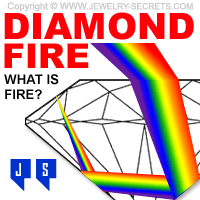
Brilliance, sparkle and fire!
Jewelry stores often talk about diamonds having brilliance, sparkle and fire.
Most can understand brilliance and sparkle… But fire?
What the heck is fire in a diamond?
Is the diamond really on fire?
No!
Fire is just a play of light.
Think about washing your car. When the rays of sun hit the stream of water, what happens? You see a rainbow of colors. Those bright flashes of color is what we refer to as “fire” in a diamond.
Fire is color.
Just look at any rainbow and you’ll see the beautiful color effects.
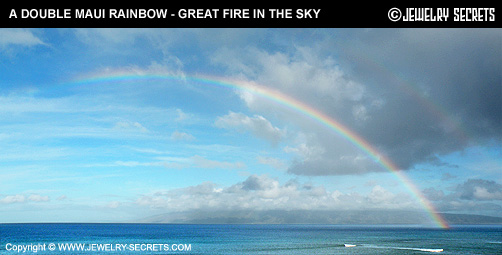
Diamonds and light
Light reacts with diamonds exceptionally well.
The reason being: diamonds are transparent.
Light can easily pass through a diamond versus a more dense stone like sapphire or garnet.
Diamond light can be defined as 3 different categories: brilliance, fire, and scintillation. Let’s look at them:
Brilliance
Brilliance (also called brightness) is the white light that emits from the surface and interior of a diamond.
Fire
Fire (also called dispersion) is when light that enters a diamond is split into all the different colors of the rainbow. Fire is colored light.
Scintillation
Scintillation are the sparkle effects that a diamond gives off. When you tilt or rotate a diamond in the light, the flashes and sparkles that you see are scintillation. Sparkles are what gives a diamond beauty and life.
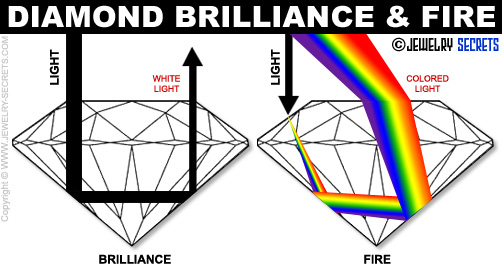
What causes brilliance and fire?
Brilliance and fire is caused by the proper cuts and proportions of a diamond.
With the correct cut, both brilliance and fire can be maximized to their full extent. This gives your diamond more dazzle.
If the stone is cut too deep or too shallow, light escapes out of the bottom of the diamond and is lost (less sparkle).
A great cut can make all the difference in the world.
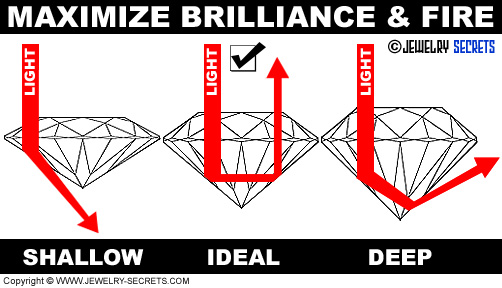
Read more about diamonds leaking light.
Ideal cuts
A great cut is generally considered an ideal cut.
An ideal cut has a table (top flat part of the diamond) of 53-57%, and a depth (total depth of the diamond) of 57.5-63%. Look at any diamond certificate to view these percentages.
A diamond cut with ideal proportions will give you a good mix of both white light (brilliance) and colored light (fire).
Take a look at the proportions and percentages of an ideal cut diamond.
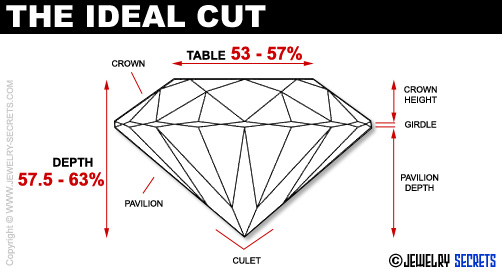
A great cut is a great thing to have.
How table size affects light
If you have a larger table, like 75% or larger, you will see more white flashes of light in the diamond. This is because light comes into the stone perpendicular.
If the table is too small, like 41% or smaller, you will see more colored flashes of light. This is because most of the light is coming into the ciamond on an angle.
To understand light better, you have to think about how light reacts with a diamond…
Light interaction
Light has 3 reactions when it comes in contact with a ciamond:
- Reflection
- Transmission
- Angle of Incident
Let’s take a closer look at these:
Reflection
Reflection is light that bounces off the surface of the stone.
The more parallel you hold the stone to the light source, the more reflection you will get.
Think about light shining on a store front window. At the right angle, the light is so bright that you can see your own reflection in the glass. It’s almost like a mirror. You can see your reflection, but you can also see right through the glass… That is called transmission.
Transmission
Transmission is when light passes right through the surface of the stone (or window or material). It passes right through the surface of a diamond which allows the light to bounce around inside the stone and give you back sparkles and fire.
Angle of Incident
The angle of incident is what makes the light come to life.
When light enters a diamond through the table, it comes straight down and strikes the pavilion (base of the diamond). Because of the angle (or slant) of the pavilion, it causes this light to bounce straight across to the opposite side and once again, bounce back out the top of the stone. This is called brilliance.
The angles of the facets, give us the critical angles which causes light to bounce.
When light enters through the crown facets (facets around the table), the light is slowed down because of the density of the diamond (much like the rainbow where water bends the light). Light that is slowed down gets bent and broken up into different wavelengths.
Dispersion is the result (diamond had a dispersion of 0.044). Dispersion is the difference between the red rays and violet rays and the refractive indices (RI).
In other words:
It separates white light into a spectral of colors.
4 factors influence diamond fire
There are 4 things that affect the fire of a diamond:
1) The angle at which the light enters the diamond.
2) The amount of light that bounces inside the diamond.
3) The amount of light that strikes the corners where the facets meet.
4) The angle in which the light exits the diamond.
These all have to work together to achieve great brilliance and fire.
Light also affects light
The type of light you view a diamond under can also play a huge role in how a diamond sparkles.
Take a look at the 2 main types of light sources:
Diffused light
Diffused light are fluorescent lights. Fluorescents help enhance the brightness and white light a diamond gives off.
But… this hinders fire at the same time.
Directional lighting
Directional lights are spotlights, light bulbs or sunlight.
Direct light that’s focused on a diamond will enhance the fire in a diamond.
But… directional light hinders brilliance.
This is why most jewelry stores carry a mixture of lights, both fluorescents (usually inside the showcases), and spot lights (halogens) over the cases.
This combo of lights helps bring out both brilliance and fire. It makes the diamonds sparkle like crazy.
The more light you have, the more life you will see.
Viewing a diamond in a dark room, or in shadows, will make a diamond look dark, dull and lifeless.
One other type of light that can affect the look of diamonds is colored light.
Colored light
Colored lights, like red lights, blue lights, neon lights, and even “OPEN” signs, can transmit colored hues into the diamond.
These transmitted colors can give a false impression of fire.
Don’t let colored lights fool you.
This is why I always recommend viewing a diamond in a natural setting, or even outside if possible, just so you can see what the diamond will really look like.
What sparkles more than a diamond?
It’s a fact, diamond sparkles more than just about any natural gemstone on the face of the Earth.
That’s what makes diamond so awesome.
But, there are a couple of gemstones that actually sparkle more than a diamond does.
These stones are synthetic stones (manmade). Gems like CZ, which is cubic zirconia. CZ’s have more fire than a diamond has because CZ’s have a higher dispersion value than diamond.
This massive amount of fire is one of the easiest ways to tell the difference between a CZ and a diamond.
Read more: CZ or Diamond?
Other manmade gemstones that have more fire than a diamond are:
- Synthetic Rutile
- Strontium Titanate
- Synthetic Moissanite
Grading the cut
If you want to know how a diamond stands up to light….
Look at the cut.
GIA (The Gemological Institute of America) grades the cut of a diamond with 5 different cut scales:
- Excellent
- Very Good
- Good
- Fair
- Poor
View any recent GIA full diamond report (the larger reports) as well as the smaller dossier reports and you’ll more than likely see GIA’s new cut grade. Older diamond reports (before 2005) will not have these.
Below is an example of what an excellent GIA cut grade looks like:
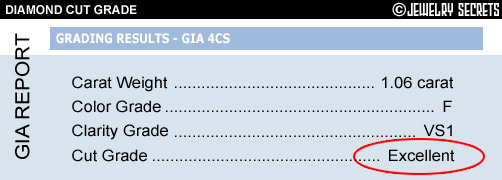
Good, Very Good or Excellent are the Targets to Shoot for. They will give you the most brilliance and sparkle and fire from any diamond.
Also keep an eye on the table and depth percentages as listed above.
If you want more “life” in your stone, you must look at the cut.
I always say, if the diamond doesn’t sparkle, it’s not worth buying.
What makes diamonds sparkle less?
There are a couple of other things besides a bad cut that can keep your diamond from sparkling…
Fluorescence
If a diamond has strong fluorescence (also listed on the diamond report), it can cause the diamond to look hazy, foggy or milky, and make the diamond sparkle less.
Inclusions
The more inclusions a diamond has, the less light is able to bounce around and exit the diamond.
When light hits flaws and imperfections, it stops the light dead in its tracks. So the more inclusions you have, the less sparkles you will see.
Lastly…
Dirt
If your diamond is dirty, your diamond won’t sparkle like it should.
Clean your stone often. Don’t touch your diamond either with your fingers. Oils get transmitted and stick to the surface of the diamond where it collects dust and dirt.
Make sure you clean the bottom of your diamond as well (buy yourself an ultrasonic jewelry cleaner or a steam cleaner). Keep dirt from building up on the pavilion. A dirty pavilion causes light to leak more.
A clean diamond will always maximize brilliance, sparkle and fire.
The more, the merrier!
Cheers! :)


















Leave a comment